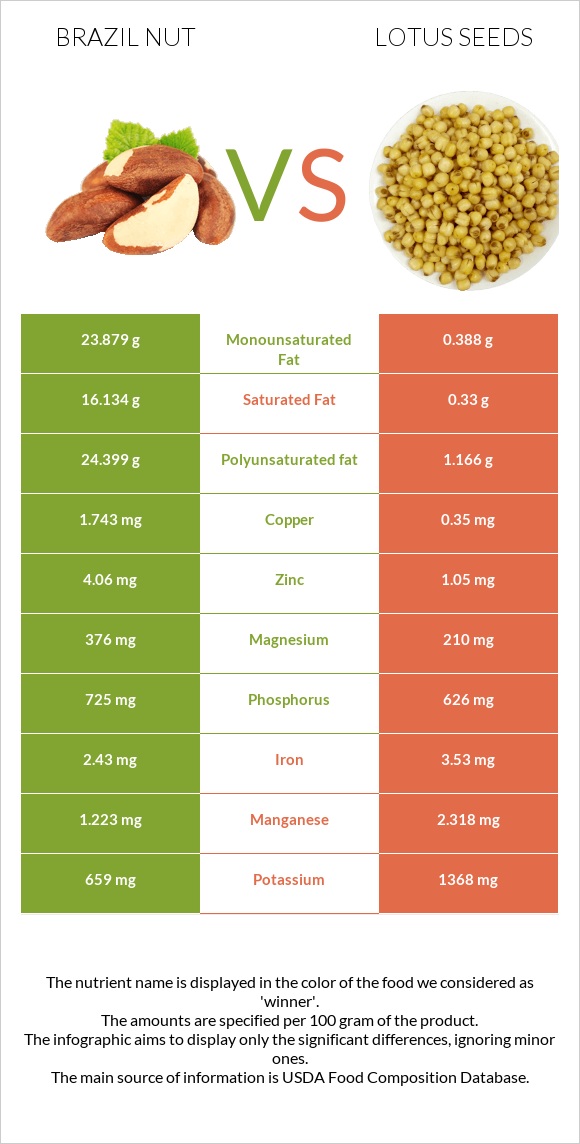Brazil nut vs. Lotus seeds — In-Depth Nutrition Comparison
Compare
Differences between brazil nut and lotus seeds
- Brazil nut has more copper, magnesium, zinc, and phosphorus, while lotus seeds have more manganese, vitamin B6, potassium, folate, and iron.
- Brazil nut's daily need coverage for copper is 155% higher.
- Lotus seeds contain 49 times less saturated fat than brazil nut. Brazil nut contains 16.134g of saturated fat, while lotus seeds contain 0.33g.
- Brazil nut has a lower glycemic index. The glycemic index of brazil nut is 10, while the glycemic index of lotus seeds is 45.
The food types used in this comparison are Nuts, brazilnuts, dried, unblanched and Seeds, lotus seeds, dried.
Infographic

Infographic link
Mineral Comparison
Mineral comparison score is based on the number of minerals by which one or the other food is richer. The "coverage" charts below show how much of the daily needs can be covered by 300 grams of the food.
| Contains more MagnesiumMagnesium | +79% |
| Contains more CopperCopper | +398% |
| Contains more ZincZinc | +286.7% |
| Contains more PhosphorusPhosphorus | +15.8% |
| Contains less SodiumSodium | -40% |
| Contains more SeleniumSelenium | +∞% |
| Contains more PotassiumPotassium | +107.6% |
| Contains more IronIron | +45.3% |
| Contains more ManganeseManganese | +89.5% |
Vitamin Comparison
Vitamin comparison score is based on the number of vitamins by which one or the other food is richer. The "coverage" charts below show how much of the daily needs can be covered by 300 grams of the food.
| Contains more Vitamin CVitamin C | +∞% |
| Contains more Vitamin EVitamin E | +∞% |
| Contains more Vitamin AVitamin A | +∞% |
| Contains more Vitamin B2Vitamin B2 | +328.6% |
| Contains more Vitamin B3Vitamin B3 | +442.4% |
| Contains more Vitamin B5Vitamin B5 | +362.5% |
| Contains more Vitamin B6Vitamin B6 | +522.8% |
| Contains more FolateFolate | +372.7% |
All nutrients comparison - raw data values
| Nutrient |  |
 |
DV% diff. |
| Selenium | 1917µg | 3485% | |
| Copper | 1.743mg | 0.35mg | 155% |
| Polyunsaturated fat | 24.399g | 1.166g | 155% |
| Fats | 67.1g | 1.97g | 100% |
| Saturated fat | 16.134g | 0.33g | 72% |
| Monounsaturated fat | 23.879g | 0.388g | 59% |
| Manganese | 1.223mg | 2.318mg | 48% |
| Vitamin B6 | 0.101mg | 0.629mg | 41% |
| Magnesium | 376mg | 210mg | 40% |
| Vitamin E | 5.65mg | 38% | |
| Fiber | 7.5g | 30% | |
| Zinc | 4.06mg | 1.05mg | 27% |
| Potassium | 659mg | 1368mg | 21% |
| Folate | 22µg | 104µg | 21% |
| Carbs | 11.74g | 64.47g | 18% |
| Calories | 659kcal | 332kcal | 16% |
| Iron | 2.43mg | 3.53mg | 14% |
| Phosphorus | 725mg | 626mg | 14% |
| Vitamin B5 | 0.184mg | 0.851mg | 13% |
| Vitamin B2 | 0.035mg | 0.15mg | 9% |
| Vitamin B3 | 0.295mg | 1.6mg | 8% |
| Choline | 28.8mg | 5% | |
| Protein | 14.32g | 15.41g | 2% |
| Vitamin B1 | 0.617mg | 0.64mg | 2% |
| Vitamin C | 0.7mg | 0mg | 1% |
| Net carbs | 4.24g | 64.47g | N/A |
| Calcium | 160mg | 163mg | 0% |
| Sugar | 2.33g | N/A | |
| Starch | 0.25g | 0% | |
| Sodium | 3mg | 5mg | 0% |
| Vitamin A | 0µg | 3µg | 0% |
| Tryptophan | 0.135mg | 0.221mg | 0% |
| Threonine | 0.365mg | 0.747mg | 0% |
| Isoleucine | 0.518mg | 0.765mg | 0% |
| Leucine | 1.19mg | 1.215mg | 0% |
| Lysine | 0.49mg | 0.985mg | 0% |
| Methionine | 1.124mg | 0.267mg | 0% |
| Phenylalanine | 0.639mg | 0.767mg | 0% |
| Valine | 0.76mg | 0.991mg | 0% |
| Histidine | 0.409mg | 0.43mg | 0% |
| Omega-3 - ALA | 0.018g | N/A | |
| Omega-6 - Gamma-linoleic acid | 0.018g | N/A | |
| Omega-6 - Linoleic acid | 23.859g | N/A |
Macronutrient Comparison
Macronutrient breakdown side-by-side comparison
Protein:
14.32 g
Fats:
67.1 g
Carbs:
11.74 g
Water:
3.42 g
Other:
3.42 g
Protein:
15.41 g
Fats:
1.97 g
Carbs:
64.47 g
Water:
14.16 g
Other:
3.99 g
| Contains more FatsFats | +3306.1% |
| Contains more CarbsCarbs | +449.1% |
| Contains more WaterWater | +314% |
| Contains more OtherOther | +16.7% |
~equal in
Protein
~15.41g
Fat Type Comparison
Fat type breakdown side-by-side comparison
Saturated fat:
Sat. Fat
16.134 g
Monounsaturated fat:
Mono. Fat
23.879 g
Polyunsaturated fat:
Poly. Fat
24.399 g
Saturated fat:
Sat. Fat
0.33 g
Monounsaturated fat:
Mono. Fat
0.388 g
Polyunsaturated fat:
Poly. Fat
1.166 g
| Contains more Mono. FatMonounsaturated fat | +6054.4% |
| Contains more Poly. FatPolyunsaturated fat | +1992.5% |
| Contains less Sat. FatSaturated fat | -98% |





